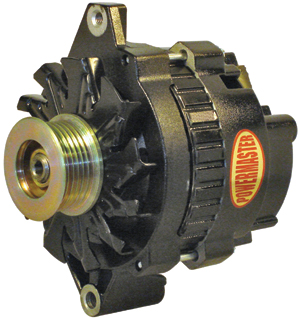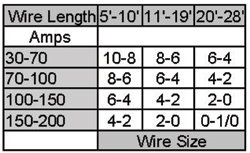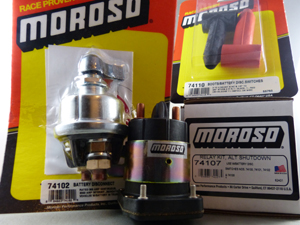| |
| Alternator
& Charging System Basics |
|
|
(More
tech articles on the Tech, Tests & Installs page HERE)
I
had an electrical fire in the Dodge earlier this season.
For
those of you who’ve never had an electrical fire,
it’s pretty scary. The Dodge was in my shop and
I had just put my new motor in it. I had just started
it up and had it running, getting some heat into it. I
had my back to the car as I was getting my timing light
ready. All of a sudden it just shut off, but I could hear
the fan still running. I turned around and saw plumes
of thick, acrid smoke billowing from the trunk, which
thankfully had been open. I ran to the back of the car
and found the alternator wire in flames and starting to
ignite the other things I had been storing in the trunk
while the engine had been out of the car. Being that the
car had shut itself off, there was no more energy flowing
through the wire so the fire went out pretty quickly at
that point. Still, this was a wake-up call. What had happened
was my alternator had a dead-short that I was not aware
of, which sent way too much juice through the charge wire
going back to the battery.
I
spoke with my sponsor Powermaster Performance to learn
more about what might have happened. Powermaster
Performance specializes in starters and high-amp alternators
for a variety of applications including drag racing. According
to Brady Basner of Powermaster, one of
the problems I had in addition to the dead-short was the
size of the wire from the alternator to the battery; it
was a 10 gauge. “The thing I always tell people
is to look at it like plumbing,” said Brady. “From
an alternator's point of view, it needs a clear path to
the battery to charge properly, and a 10 gauge wire to
the back of the car is extremely small. This will create
a great deal of resistance (heat) in the wiring.”
Too small of a charge wire will also result in a loss
of voltage. Brady also informed me that they could repair
my alternator even though it was not a Powermaster unit.
They can fix up any starter or alternator regardless of
manufacture.
 So
now I’ll be starting from scratch, rewiring the
Dodge* and installing new components.
How to begin? By doing some research. There’s an
excellent resource in the Tech section of Powermaster’s
website entitled “How
To Choose A Racing Alternator." It details
step-by-step the right way to choose and set-up the correct
charging system for any application. Visit the page; it's
great info. (*Note:
see the rewiring job from start to finish HERE). So
now I’ll be starting from scratch, rewiring the
Dodge* and installing new components.
How to begin? By doing some research. There’s an
excellent resource in the Tech section of Powermaster’s
website entitled “How
To Choose A Racing Alternator." It details
step-by-step the right way to choose and set-up the correct
charging system for any application. Visit the page; it's
great info. (*Note:
see the rewiring job from start to finish HERE).
The
challenge facing any charging system in a race car is
that today's cars have more electrical demand than ever
before. As a result, many of us run high-amp alternators
but neglect to run a larger gauge charge wire to handle
the higher amp loads. This was one of my mistakes. Furthermore,
the pulley ratio has to be correct in order to keep the
alternator charging at various speeds but without over-spinning
it (the maximum RPM for an alternator is 18,000).
 The
first thing to do is make a list of all of the components
of your electrical system: ignition, fans, lights, water
pump, fuel pump, and so on.
Then find the amperage draw for each component,
and check with the manufacturers if need be. Total up
the amps to get the amperage draw for the vehicle, and
figure out the total length of charging wire you’ll
need to get from the alternator to the battery. Now you
can determine the size of the charging wire you’ll
need in order for it to safely handle the draw over the
distance. The
first thing to do is make a list of all of the components
of your electrical system: ignition, fans, lights, water
pump, fuel pump, and so on.
Then find the amperage draw for each component,
and check with the manufacturers if need be. Total up
the amps to get the amperage draw for the vehicle, and
figure out the total length of charging wire you’ll
need to get from the alternator to the battery. Now you
can determine the size of the charging wire you’ll
need in order for it to safely handle the draw over the
distance.
Tighten
Your Belt
According to Powermaster, the #1 reason for alternator
failure including no output is a slipping belt. This has
become a bigger problem with high-amp alternators because
the higher the amps, the more resistance the alternator
has and it takes more power to turn it. Signs of a slipping
belt include:
-
Little
or no output
-
Discharged
battery
-
Pulley
extremely hot and discolored
-
Rust
on alternator shaft,
-
Belt
dust on alternator fan and housing
-
Belt
sticking to pulley
-
Glazed
or cracked belt
-
Belt
too deep in pulley groove
-
Bearing
noise
 So
how can you determine if your belt is tight enough? Place
a socket on the alternator pulley. Using a pull handle
in the socket, pull on the handle clockwise. If the pulley
slips, it’s not tight enough. The belt should be
tight enough that it will try to actually turn the engine. So
how can you determine if your belt is tight enough? Place
a socket on the alternator pulley. Using a pull handle
in the socket, pull on the handle clockwise. If the pulley
slips, it’s not tight enough. The belt should be
tight enough that it will try to actually turn the engine.
Next
for the Dodge
will be a complete re-wiring job. I’ll also be installing
the alternator that Powermaster will rebuild as well as
additional components that Moroso Performance
Products suggested, such as their #74107
Alternator Shutdown Relay Kit, #74102 heavy-duty Battery
Disconnect Switch and #74110 Boots
for the battery disconnect switch. We’re also going
to fuse the charging wire as an extra measure.
Choosing
the right alternator and selecting the proper weight wire
will not only improve the charging system’s performance,
but it will make for a safer system. Going overkill on
safety is always a good idea, especially with electrical
systems.
Sources:
Powermaster Performance
www.PowermasterPerformance.com
Moroso
Performance Products
www.Moroso.com
|
|
|
|
|
|
|
Dragtime
News On Location |
Tech,
Tests & Installs |
Bracket
Racing 101 |
|
|
Visit
the Tech,
Tests & Installs main page. |
Visit
the Bracket
Racing 101 main page.
|
|
|
|
|
|
|
 |



